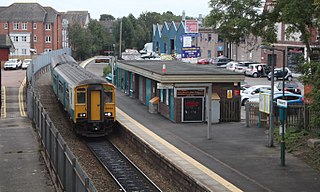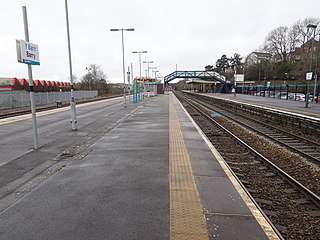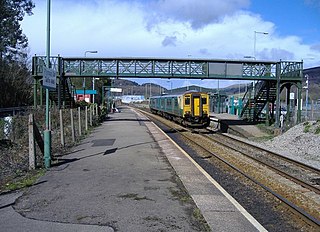Related Research Articles

The Taff Vale Railway (TVR) was a standard gauge railway in South Wales, built by the Taff Vale Railway Company to serve the iron and coal industries around Merthyr Tydfil and to connect them with docks in Cardiff. It was opened in stages in 1840 and 1841.

Cardiff Central railway station is a major station on the South Wales Main Line, located in the capital of Wales, Cardiff. It is one of the city's two urban rail network hubs, along with Cardiff Queen Street. Opened in 1850 as Cardiff station, it was renamed Cardiff General in 1924, and then Cardiff Central in 1973.

Cardiff Queen Street railway station is a railway station serving the north and east of Central Cardiff, Wales. It is the third busiest railway station in Wales, being located near Queen Street, it is one of 20 stations in the city. It is, along with Cardiff Central, one of the two major hubs of the Valleys & Cardiff Local Routes local rail network. The station, and all of its services are run by Transport for Wales.

From 1839 the Trustees of the Marquis of Bute, operated a large dock operation in Cardiff, the "Bute Docks". This was very successful, but was overwhelmed by the huge volume of coal exported through Cardiff. At the same time it was seen that railway companies, especially the Taff Vale Railway (TVR), were making money conveying the coal to the docks.
The Rhymney Railway was a railway company in South Wales, founded to transport minerals and materials to and from collieries and ironworks in the Rhymney Valley of South Wales, and to docks in Cardiff. It opened a main line in 1858, and a limited passenger service was operated in addition.

Penarth railway station is the railway station serving the town of Penarth in the Vale of Glamorgan, South Wales. It is the terminus of Network Rail's Penarth branch running from Cogan Junction to Penarth station, 1 mile 12 chains from the junction and 2 miles 67 chains south of Cardiff Central station. The Penarth branch ran from Cogan Junction to Biglis Junction, a rail mileage of 5 miles 65 chains and was officially closed beyond Penarth after the last passenger train ran on Saturday 4 May 1968.

Barry Island railway station is a railway station, 9¼ miles (15 km) south-west of Cardiff Central, serving Barry Island in South Wales. The station has been the terminus – and only remaining active station at the end of the Barry branch of the Cardiff Central to Barry Island line since the closure of Barry Pier station in 1976, the last passenger working through Barry Island tunnel to the Pier station being an enthusiasts' special in 1973. Previous to that year, only a few revenue-earning workings to meet up with the former P&A Campbell's paddle-steamer trips to Weston-super-Mare or other Somerset/Devon havens, were made following May 1964.

Barry railway station is one of three stations serving the town of Barry, Vale of Glamorgan in South Wales. It is one of three stations in Barry. This one, Barry Town, is preceded by Barry Docks and Cadoxton stations on the Barry Branch which runs from Cardiff Central to a fourth station at Barry Island, the terminus. Barry is also the junction at the start of the Vale of Glamorgan Line which serves Rhoose and Llantwit Major and terminates at Bridgend.

Radyr railway station is a railway station serving the Radyr area of Cardiff, South Wales. It is at the foot of the hill at the eastern edge of the village, alongside the River Taff and adjacent to the Taff Trail. The station is on the Merthyr Line, and is also the northern terminus of the City Line.

Taff's Well, is a semi-rural village, community and electoral ward located at the south easterly tip of Rhondda Cynon Taf, 6 miles (9.7 km) to the North of Cardiff, the capital city of Wales. Known locally as the 'Gates to the Valleys', it is separated from Gwaelod Y Garth by the River Taff. Taff's Well is distinguished because it contains the only thermal spring in Wales. The tepid water is thought to rise along a fault-line from the Carboniferous Limestone, in somewhat similar manner to the warm springs at Bristol and Bath. Various religious groups regard it as a spiritual site.

Taffs Well railway station is a railway station serving the village of Taff's Well, Rhondda Cynon Taf, Wales, as well as neighbouring Gwaelod-y-Garth, Cardiff. It is located on the Merthyr Line and the Rhondda Line. Passenger services are provided by Transport for Wales.

Cardiff Bay railway station, formerly Cardiff Bute Road, is a station serving the Cardiff Bay and Butetown areas of Cardiff, Wales. It is the southern terminus of the Butetown branch line 1 mile (1.5 km) south of Cardiff Queen Street.

Tan-y-Bwlch railway station is the principal intermediate passenger station on the narrow gauge Ffestiniog Railway, which was built in 1836 to carry dressed slate from Blaenau Ffestiniog to Porthmadog for export by sea. The station lies off the B4410 former turnpike road from Maentwrog to Llanfrothen and Beddgelert, which the railway crosses on a fine cast-iron skew bridge.

Porth railway station is a railway station serving the town of Porth in Rhondda Cynon Taf, Wales. It is located on the Rhondda Line.

The Barry Railway Company was a railway and docks company in South Wales, first incorporated as the Barry Dock and Railway Company in 1884. It arose out of frustration among Rhondda coal owners at congestion and high charges at Cardiff Docks as well the monopoly held by the Taff Vale Railway in transporting coal from the Rhondda. In addition, the Taff Vale did not have the required capacity for the mineral traffic using the route, leading to lengthy delays in getting to Cardiff.

Abercynon railway station is the railway station serving the village of Abercynon in the Cynon Valley, Wales. It is located on the Merthyr Line, 15.5 miles (25 km) north of Cardiff Central. Passenger services are provided by Transport for Wales.
The Llancaiach Branch railway line was a mineral branch line in Glamorganshire, South Wales. It was authorised in 1836 as part of the Taff Vale Railway, and its purpose was to connect collieries at Llancaiach and bring their output to Cardiff for onward shipment. It was designed by Isambard Kingdom Brunel and built on the standard gauge. It opened in 1841 from a junction with the Merthyr line immediately south of Abercynon. It was intended to be horse worked, and included a self-acting rope-worked inclined plane near the junction. The collieries were slow to use the line, preferring their customary use of a tramroad and the Glamorganshire Canal, and the value of the line was diminished when the Taff Vale Extension line, an east-west connecting line belonging to the Newport, Abergavenny and Hereford Railway, intersected it and cut off the colliery connections, and the line became dormant.

Glan Llyn Halt in Gwynedd, Wales, was a railway halt on the Ruabon to Barmouth line on the south shore of Bala Lake, and is a limited-use station on the Bala Lake Railway which operates over part of the same route.

Tonteg Halt refers to two railway stations serving the township of Tonteg in Rhondda Cynon Taf, Wales. They were located on the Llantrisant and Taff Vale Junction Railway and latterly on the Barry Railway under the Great Western Railway.

Walnut Tree Viaduct was a railway viaduct located above the southern edge of the village of Taffs Well, South Wales. Originally built to carry the Barry Railway across a narrow gorge through which the River Taff, Taff Vale Railway and Cardiff Railway passed, it was deconstructed in 1969, leaving only two of the support columns visible from the A470 road.
References
- ↑ Archived 2017-02-14 at the Wayback Machine Images of the line. Accessed 22/02/2017
- ↑ Hutton, J. An Illustrated History of Cardiff Docks, Volume 3. Silver Link. 2009. p.49